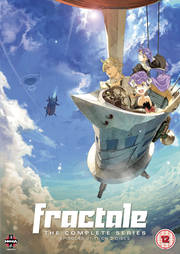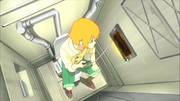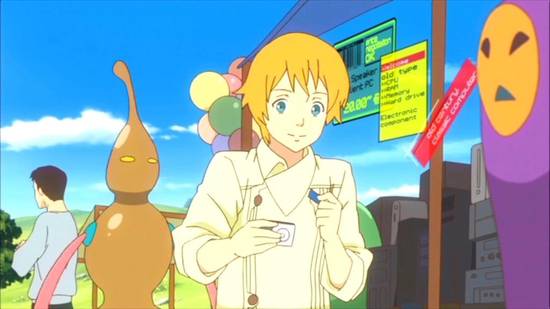Review for Fractale: Complete Series
Introduction
Anyone remember fractals? They were big twenty odd years ago, back when the infinitely repeating images, overlaid with computer simulated colours were sold as poster art. That was back when tennis players with no underwear would scratch their butts, back when tigers would pose against the planet Earth hanging in the sky, back when people would look for all kinds of meaning in magic eye pictures. They say the eighties were tacky! The eighties had nothing on the nineties. I remember the first week of my Physics degree, we learnt about fractals; about how deceptively simple mathematical equations could result in such unexpected and even more deceptive complexity. A fractal image is infinitely repeating. Zoom into any portion of a fractal, and it will render an image that is identical to the larger one. Of course poster art is the least application of fractal theory, as it can be applied to all manner of things, whether it’s explaining the formation of snowflakes, to aspects of geology and even medicine.
While science is a constant, the appreciation of art is more matter of fashion, and fractal images have been mostly left in the nineties. They do crop up from time to time though. Fractals were part of the story in Defying Gravity a couple of years ago, a high concept sci-fi series that tragically never went the distance. And now in the UK, a little later than originally intended, we get the anime series Fractale, which makes use of that fantastic imagery for its opening sequence, and might even briefly convince you that your SD TV is actually an HD screen. Coming from the noitaminA animation slot in Japan, it also promises to be more than just the usual anime show.
Clain lives in Utopia. In the 22nd Century, the Fractale technology was invented, and it completely rewrote the rules of society. In the distant future, Clain lives with the legacy of this revolution, a peaceful world governed by the Fractale Network and the implants that make it possible. War and want is a thing of the past, and human interaction has been greatly reduced. People now talk to each other through avatars called Doppels, and all their needs are catered for by the temple. The only obligation is to pray at prescribed times to that temple, and so their pastoral existence continues. Clain is an oddball though, as in a world where no-one stays together, or in one place, he’s settled down to life in an actual house. He’s also got a fascination for antiques, particularly pre Fractale technology.
Then one day, a girl fleeing from danger literally falls into his life. Phryne is something of an enigma, but Clain is sufficiently captivated to help her. In gratitude, she gives him an amulet, and then disappears from his life. It’s more than just an amulet though, as when Clain examines it, he realises it’s a significant piece of tech when he inadvertently activates it. A Doppel appears, but one that looks very much like a girl rather than a simple avatar. Also, Nessa is more than just an avatar; for one thing she can actually touch and be touched. Phryne is actually a priestess of the temple, and Clain has gotten involved in something very sinister. On top of all this, there is the conflict between the temple and the Lost Millennium group, dissidents who want to be free of the Fractale system. But it may just be that this Fractale world that Clain lives in is coming to an end.
Eleven episodes of Fractale are presented across two discs from Manga Entertainment.
Disc 1
1. Encounter
2. Nessa
3. The Village of Granites
4. Departure
5. Journey
6. The Farthest Town
Disc 2
7. Veneer Town
8. Secret of the Underground
9. No Way Out
10. To The Temple
11. Paradise
Picture
This is a little something that we don’t see a lot of these days with anime. Fractale gets a 1.78:1 anamorphic transfer which is an NTSC-PAL conversion. That’s maintaining an effective 24 frames per second on a 25 fps format by means of interpolation, and blending frames. Consequently, Fractale’s image is a little softer and of lower resolution than we have become used to of late, there is a smidgen of judder during pans and scrolls, although blended frames will only really be evident if you pause the image and frame advance until you find one. It’s a shame that the show couldn’t get a native PAL transfer. Actually it’s a shame that Manga couldn’t release a Blu-ray. As part of the noitaminA strand, the production values for Fractale are significantly higher than that for the usual television animation. While character designs may be a tad generic, taking a page from Studio Ghibli, the actual animation, and the level of detail in the world designs is up there with theatrical works. Fractale is set in a pastoral future world, with plenty of imaginative steampunk technology, and with Celtic overtones that reflect in its music soundtrack. And of course there are the fractals during the opening sequence, all of which would have benefitted from an HD treatment.
Sound
Audio comes in DD 5.1 English and DD 2.0 Stereo Japanese. There is a sole translated subtitle track to go with the Japanese audio, and given that there is no on screen Japanese text (except the episode titles which aren’t translated in the subtitles anyway), there’s no real need for a signs only track. The songs are translated in the subtitles though, so if you watch in English and want to see the theme song lyrics translated, you’ll just have to flick the subtitles on yourself.
I went with the Japanese track as always, and was very happy with the voice actor performances, which all suited their characters well. The action sequences also had a nice bit of stereo oomph to them. Fractale gets a couple of very engaging theme tunes, an electronica opening set to fractal imagery, and a very appropriate folk song ending. What really impresses is the incidental music, as Fractale really is set up like a movie sliced into eleven episodes. It thus gets a very filmic, full orchestral soundtrack that makes the show feel epic. I gave the dub a try, and the 5.1 surround does help give the show more space, and Funimation have given the show a quality dub. This is one show that is easy to listen to in both languages. The subtitles have one or two minor typos but are otherwise timed well, and free of significant error.
Extras
Manga Entertainment have sourced the Siren Visual authored discs to release here, which in this case means that some of the extra features on the US release from Funimation aren’t carried through, such as promo videos and art galleries. There’s a piece on the music soundtrack that I would have loved to have seen, and if ever a show deserved a textless opening credit sequence, it’s this one. What we do get are eleven episodes spread across two discs, presented with static menus.
Note that Play All doesn’t work on disc 2. It will play up to episode 9, and then drop to the Siren Visual credits screen. You’ll then have to go to the episode select menu and choose episodes 10 and 11 individually.
Disc 1 gets an audio commentary on the first episode, with Adaptive Scriptwriter J. Michael Tatum joined by voice of Sunda, Scott Freeman. It’s an interesting conversation about the show, which while not necessarily scene specific, does go into some of the themes and ideas. It also has a couple of spoilers, so you might want to leave it until after the series.
Disc 2 gets the USA Trailer, which lasts 2 minutes, and an audio commentary to accompany episode 7. Here ADR Director Colleen Clinkenbeard and voice of Clain, Brina Palencia sit in the booth, chat and giggle, although there are some interesting points to note about the show as well. Incidentally why do ADR Directors so often introduce themselves on commentaries as the director of the show? They direct the dub, not the show! That was personal bugbear #785.
Conclusion
Do we really need to see the Matrix yet again? For Fractale is just another look at The Matrix story, albeit without the bullet time and kung fu, and in a more pastoral, post industrial setting. It’s nowhere near as good as The Matrix, but it is as enjoyable as The Matrix Reloaded, and it’s miles better than The Matrix Revolutions. It’s also consistent in storytelling quality across its episodes, and as such delivers a more satisfying story than the Matrix trilogy did in the end. In some ways it’s actually an improvement. So maybe watching this particular ‘Animatrix’ is worthwhile.
As you would expect from a noitaminA block animation, Fractale is a little more than just your average sci-fi anime show. In much the same way as the Matrix movies, Fractale takes a look at the philosophical questions behind the definition of humanity, our reliance on technology, how it isolates us, and the importance in our lives of free will, balanced against our need to depend on others, on authority, and indeed on a higher power.
In this future world, the Fractale system that gives humanity its wondrous and peaceful utopia is set up like a religion. People are implanted with the technology that allows them to participate and take advantage of Fractale, and the price of that is a requirement to be connected to the system for uploads to occur. This is presented as prayer, that time of the day that people are expected to pray to the temple, represented by the nearest Fractale star. In reality they are linking to the nearest Fractale node. The Fractale system is the Internet, Nanotechnology and Holographics used to engineer the ideal world, where participants in the system can see the world idealised as the system allows, where interactions can all be accomplished at a distance through avatars or doppels, and where a person’s healthcare needs can be fulfilled by remote. It is the perfect utopia where war doesn’t need to exist, where no one wants for anything, where conflict is unimaginable.
The problem comes when the system starts to break down through age, and the artificial stars that represent the Fractale nodes, and project the system across the world, start failing. The system needs to be reinitialised, and for that there is the Fractale Key. This is embodied in the form of a girl named Phryne, and as with such things, human nature taints even the most noble of endeavours. The Temple wants to hold onto its power, and Phryne is a priestess that has been raised solely for the purpose of being this key. There’s been no thought as to her emotional wellbeing, and the story begins with her escape from the temple, and when she falls into the lap of the show’s protagonist Clain, leaving him with a very unique doppel named Nessa.
Clain has taken the Fractale system for granted all his life, albeit with an unnatural predilection for staying in one place, and a fascination for antiques. Encountering Nessa and Phryne makes him start to think about the world that he lives in, whether it is actually healthy for people to be so reliant on a single system, so devoted to the Temple that controls it. It soon becomes clear that there are opposing opinions to the prevailing one, when they encounter the Lost Millennium group. They’re a group of freedom fighters that has shunned the Fractale system, and are living their lives the way that people used to before Fractale. That they want to bring this state of affairs to the rest of the world brings them into direct conflict with the temple, as both sides want control of the key. Clain winds up in the middle of all this with Nessa and Phryne, and the journey that they take exposes them to both viewpoints on whether Fractale is a good thing or not.
There are a lot of things for Clain to consider, a lot of ideas presented in Fractale, and that is one of its problems. At eleven episodes, it’s too short a series to go into sufficient depth with the ideas that it toys with. The world of Fractale is a big one, with many facets, and complex ways in which humans interact with it. The story will often present an idea, play with it for an episode or so, and then leave it half formed, never fully explored. Because of this, certain aspects of the story are underdeveloped, and in certain places this applies to character development as well. I felt that Phryne in particular could have used a little more time to flesh out her character, explore her back-story, unsavoury though it was.
The second thing is that there is an unevenness of tone about Fractale, which while it doesn’t harm the show, does make it uncomfortable to watch at times. This is one instance that noitaminA got caught by the tendency to play to the mainstream audience, and there are cutesy moments in the show, moe characters, a little bit of tsundere, our hero accidentally seeing the heroine naked, accusations of perversion, silliness and pratfalls that all ought to be in lesser, more mainstream anime. Then all of a sudden the reality of the show would hit with a jarring suddenness, the conflict between Lost Millennium and the Temple would flare up, bullets would start flying, and wholesale massacres would occur, at one point with innocent bystanders caught in the middle. The bloodiness and brutality would jar with the almost childlike fantasy aspects of the show. Despite the opening of the story reminding me strongly of Ghibli’s Laputa: Castle in the Sky, this is in actuality a harsher and darker story, very much in the vein of the Matrix movies.
Despite these issues, Fractale really did entertain, and with its final episode it even transcended its shortcomings. The story gets a conclusion that is very satisfying, a very fitting climax and one that caps off the various character arcs in just the right ways. Also, with its pastoral setting, the Celtic overtones and the general feel of a theatrical feature, Fractale really goes beyond its television anime origins and becomes something special indeed. It’s definitely a show that will be high up on the re-watch pile, as it manages to entertain and get the grey matter working as well. It’s a shame that Manga have only got it out on DVD, although it was licensed during that period when Blu-ray costs were significantly higher for them. This year they are revisiting the Fullmetal Alchemist Brotherhood series on Blu-ray, now that it is economic enough for them to be released, and hopefully Fractale will get the same treatment as well. Its US Blu-ray is annoyingly locked to Region A, and Siren Visual have only released it on DVD in Australia.

















































































Your Opinions and Comments
Be the first to post a comment!